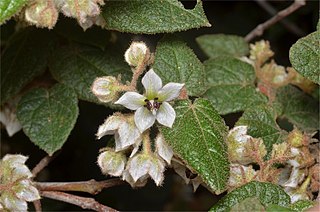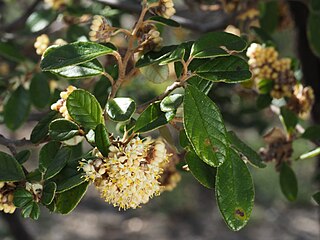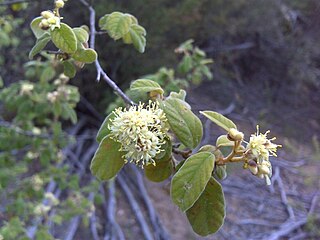
Lasiopetalum behrii, commonly known as the pink velvet bush, is a species of flowering plant in the family Malvaceae and is endemic to southern continental Australia. It is an erect shrub with lance-shaped, narrowly oblong to narrowly elliptic leaves and groups of white to pink and reddish-brown flowers.

Lasiopetalum ferrugineum, commonly known as rusty velvet-bush, is a species of flowering plant in the mallow family and is endemic to eastern Australia. Growing up to a metre tall, much of the plant is covered in rusty hairs. It is found in forest and heathland.

Lasiopetalum schulzenii, commonly known as drooping velvet-bush, is a species of flowering plant in the family Malvaceae and is endemic to southern continental Australia. It is a shrub with heart-shaped leaves and small groups of hairy white and reddish-brown flowers.

Pomaderris ferruginea, commonly known as rusty pomaderris, is a species of flowering plant in the family Rhamnaceae and is endemic to south-eastern continental Australia. It is a shrub with rusty-hairy stems, egg-shaped leaves, and clusters of cream-coloured, whitish or yellow flowers.

Pomaderris lanigera, commonly known as woolly pomaderris, is a species of flowering plant in the family Rhamnaceae and is endemic to south-eastern continental Australia. It is a shrub or small tree with hairy stems, lance-shaped to egg-shaped or elliptic leaves, and hemispherical clusters of yellow flowers.

Pomaderris vellea, commonly known as woolly pomaderris, is a species of flowering plant in the family Rhamnaceae and is endemic to eastern Australia. It is an erect shrub with curly-hairy stems, oblong to circular leaves, and dense panicles of yellow flowers.

Lasiopetalum rufum is a species of flowering plant in the family Malvaceae and is endemic to the Sydney region of New South Wales. It is a slender, erect or diffuse shrub with linear leaves and small groups of reddish or pinkish flowers.

Pomaderris andromedifolia is a species of flowering plant in the family Rhamnaceae and is endemic to south-eastern continental Australia. It is a shrub with lance-shaped to elliptic leaves and cream-coloured to yellow flowers.

Pomaderris betulina, commonly known as birch pomaderris, is a species of flowering plant in the family Rhamnaceae and is endemic to south-eastern continental Australia. It is a shrub with hairy young stems, lance-shaped to oblong or elliptic leaves, and yellowish flowers.
Lasiopetalum adenotrichum is a species of flowering plant in the family Malvaceae and is endemic to the Fitzgerald River National Park in the south of Western Australia. It is an erect shrub with hairy foliage, narrow egg-shaped to lance-shaped leaves and groups of white to cream-coloured and dark reddish-purple flowers.
Lasiopetalum cenobium, is a species of flowering plant in the family Malvaceae and is endemic to a restricted part of the south-west of Western Australia. It is only known from the type location, not having been collected since 1918.
Lasiopetalum compactum, is a species of flowering plant in the family Malvaceae and is endemic to the south-west of Western Australia. It is an erect shrub with leathery, narrowly oblong leaves and cymes of white to pinkish flowers.
Lasiopetalum joyceae is a species of flowering plant in the family Malvaceae and is endemic to New South Wales. It is an erect shrub with linear leaves and small groups of pinkish to reddish-brown flowers.
Lasiopetalum longistamineum is a species of flowering plant in the family Malvaceae and is endemic to a restricted area of New South Wales. It is a spreading shrub with its branches densely covered with woolly, rust-coloured hairs and has egg-shaped leaves and woolly-hairy flowers.

Lasiopetalum oppositifolium is a species of flowering plant in the family Malvaceae and is endemic to the south-west of Western Australia. It is an open, erect shrub with rusty-hairy young stems, linear, narrowly elliptic or narrowly egg-shaped leaves and white, pink and dark red flowers.

Pomaderris pauciflora is a species of flowering plant in the family Rhamnaceae and is endemic to the south-east of continental Australia. It is a shrub with hairy stems, mostly lance-shaped leaves with the narrower end towards the base, and panicles of cream-coloured flowers.

Lasiopetalum parviflorum is a species of flowering plant in the family Malvaceae and is endemic to south-eastern continental Australia. It is a shrub with rusty-hairy stems, more or less glabrous leaves with the edges rolled under, and greenish to cream-coloured flowers.

Lasiopetalum trichanthera is a species of flowering plant in the family Malvaceae and is endemic to a restricted area in the south-west of Western Australia. It is an erect to straggling, sticky shrub with many hairy stems, egg-shaped leaves and bright pink and dark red flowers.

Pomaderris subcapitata is a species of flowering plant in the family Rhamnaceae and is endemic to south-eastern continental Australia. It is a shrub with hairy stems, elliptic to egg-shaped leaves and dense clusters of cream-coloured or yellow flowers.

Epacris paludosa, commonly known as swamp heath, is a species of flowering plant from the heath family, Ericaceae, and is endemic to eastern Australia. It is an erect, bushy shrub with lance-shaped, elliptic or egg-shaped leaves and tube-shaped white or cream-coloured flowers in crowded, leafy heads at the ends of branches.

















